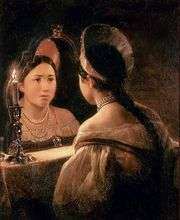Catoptromancy

Russian folk catoptromancy by Karl Briullov, 1836
Catoptromancy (Gk. κάτοπτρον, katoptron, "mirror," and μαντεία, manteia, "divination"), also known as captromancy or enoptromancy, is divination using a mirror.
Pausanias, an ancient Greek traveler, described as follows:
Before the Temple of Ceres at Patras, there was a fountain, separated from the temple by a wall, and there was an oracle, very truthful, not for all events, but for the sick only. The sick person let down a mirror, suspended by a thread till its base touched the surface of the water, having first prayed to the goddess and offered incense. Then looking in the mirror, he saw the presage of death or recovery, according as the face appeared fresh and healthy, or of a ghastly aspect.
In Ancient Rome, the priests who used catoptromancy were called specularii.[1]
See also
References
- ↑ Sadowski, Piotr (23 September 2009). From Interaction to Symbol: A systems view of the evolution of signs and communication. John Benjamins Publishing Company. p. 152. ISBN 9789027288905.
Further reading
- Armand Delatte, La catoptromancie grecque et ses dérivés (1932)
External links
This article is issued from Wikipedia - version of the 10/29/2016. The text is available under the Creative Commons Attribution/Share Alike but additional terms may apply for the media files.